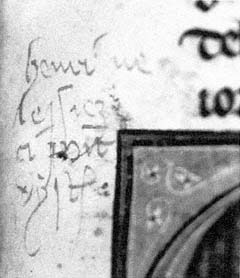Politics in the Duchy of Normandy
Charles V's interest in the history of the Norman dukes is not surprising in light of contemporary events. In the mid-1350s John the Good made Charles duke of Normandy.[7] In this capacity he had to contend with the attempts of his cousin, Charles of Navarre, to foment rebellion from his base in Evreux as part of an attempt to win the French throne. The situation was complicated by the activities of the English king, Edward III, a second claimant to the throne who periodically invaded Normandy. Charles V's attempts to gain control of Normandy were successful. With the Treaty of Brétigny in 1360 and Charles of Navarre's homage at Vernon in 1371, Charles V made tentative peace with his rivals. Nevertheless, as the French land closest to England, the duchy of Normandy remained a point of contention throughout Charles V's reign.
Charles's role as duke of Normandy may explain the pictorial emphasis on the lives of Norman dukes in his chronicle. By emphasizing a number of events in the history of the early dukes, rubrics and illustrations introduced into the book establish parallels between Charles's ducal predecessors and his royal ancestors. Some of the textual changes specified in the margins of Philip III's Grandes Chroniques highlight the activity of the early Norman rulers. First, they suggest the inclusion of new rubrics that increase the prominence of Dukes Rollo (Robert I) and Raoul of Normandy and Kings Louis, Lothar, Robert II, and Henry of France. In addition, they advocate the subdivision of certain chapters to stress divine intervention in the conquest of Normandy (the appearance of Saint Benedict to Count Sigillophes), emphasize the Christianity of the early dukes (the baptism of Rollo at which he took the name Robert), and discuss treachery against the Normans (the treason of the count of Flanders). They also note the Normans' ability to seek peace (alliance with King Lothar of France) and praise their repulsion of an English invasion (by Ethelred II) and their willingness to go on crusade. The only chapter formed by subdivision that deals with a French king discusses Robert II's generosity to the abbey of Saint-Denis just before his death.
The placement of miniatures, also noted in the margins of Philip's Grandes Chroniques , places equal emphasis on the importance of the Norman subcycle. For instance, the only annotation recommending suppression of an image occurs on folio 209 (Figs. 12 and 69), where a note to Henri suggests that he skip a miniature depicting Richard of Burgundy chasing the Normans out of his realm in order to insert a picture of the Normans landing in Neustria, two paragraphs later, at the commencement of the description of Rollo's activities. Three other miniatures illustrate chapters created by the subdivision of this portion of Primat's text.[8]
These newly subdivided chapters describe traits in the Norman predecessors of Charles V that were normally attributed to French kings. Chapters focusing on divine sponsorship, the repulsion of an English invasion, and the willingness to crusade illustrate kingly behavior. One chapter is subdivided to introduce a miniature celebrating the baptism of Rollo (Fig. 70), the first Christian duke of

Figure 69
Inscription addressed to Henri de
Trévou. Grandes Chroniques de France .
Bibliothèque Sainte-Geneviève, Ms. 782,
fol. 209. Photograph by the author.
Normandy. This event parallels the baptism of Clovis, the first Christian king of France. Clovis's baptism was especially important to the French kings because, according to legend, the holy unction that distinguished the French rulers from all others first appeared at Clovis's baptism.[9]